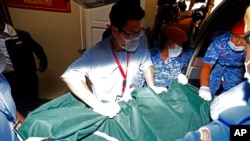Dr. Kathreena Kadir pumps sanitizer onto her hands and rubs them thoroughly before proceeding to put on her personal protective equipment, or PPE, including shoe covers, a gown and face mask.
It’s a standard procedure this oral and maxillofacial surgeon at the University of Malaya Medical Center now follows before meeting patients so she doesn’t contract the coronavirus.
“Every patient that comes through the doors is considered positive until proof otherwise,“ says Dr. Kadir. “So, we need to make sure that we are fully prepared and protected when treating the patients.”
The plastic face shield she is wearing was not produced in a factory or even by a company. It was made in a small house about 10 kilometers from the medical center.
It’s where William Alvisse, 52, has turned his family’s dining room into a production hub. Eight 3-D printers run almost non-stop making the shields.
So far, Alvisse’s family has spent $1,500 of their own money to make thousands of shields for hospitals across Malaysia.
“I’m doing this because the front liners are the most important people right now,” Alvisse says. “No other people are more important than the front liners and if they need something, then I have to produce it. That’s my thinking.”
Alvisse runs the printers during the day while son Daryl, 20, does so overnight.
The family is part of a Facebook group of more than 500 active members across Malaysia producing PPE for health workers. Altogether, the group has made more than 400,000 face shields, 2,000 aero chambers (inhalers) and several hundred incubation boxes.
“We heard volunteers were using 3-D printers to help front liners in other countries so we thought we should start this up in Malaysia as well,” says Wan Cheng Huat, one of the founders of the group, 3-D Printing Malaysia Community for COVID-19. The illness is caused by the coronavirus.
The group has expanded to bring in volunteers with skills beyond 3-D printing, including sewing. “The group’s members share a common bond of wanting to pitch in during this time of need,” Wan says, adding that most of the members don’t charge for the PPE they produce. “Most of us have never met face-to-face, but we’re meeting this challenge together.”
Alvisse is a salesman for an e-learning company but has only worked a few days since mid-March because of concerns about COVID-19. Before the coronavirus pandemic started, Alvisse already had one 3-D printer in his home and after he began producing face shields several friends pitched in about $2,300 to buy four more. The remaining three printers came from a local community center Alvisse co-founded that has been closed since mid-March.
Alvisse says making the face shields brings him satisfaction for a couple of reasons.
“I got into this because I like to do a lot of tinkering,” he says. “I love community. So these are two elements of bringing the tinkering and community together into this field.”
The process starts with spooled plastic filament fed into a 3-D printer, where it is melted and layered onto a heated plate and shaped into a frame. Each of the 3-D printers at Alvisse’s home produces two frames at a time in about one hour. Alvisse’s wife, Miranda Tan, attaches a clear plastic sheet to the frames, for the shield that’s providing the protection.
On a recent afternoon, the sofas and chairs in the family's living room were stacked with bags of shields bound for Malaysian hospitals. “Sometimes I get annoyed because it’s so difficult just to move around in here with these piles of face shields,” Miranda Tan said with a slight chuckle. ”But, I’m glad we’re doing this. Eventually we’ll get all of this space back.”
The contributions of the volunteers have not gone unnoticed by medical workers such as Kadir.
"I would like to say a big thank you to all of these volunteers who’ve come up with a lot of donations and efforts in making sure the front liners are always well protected,” she says.




